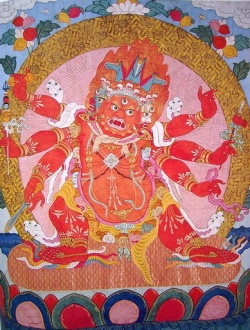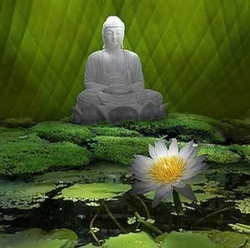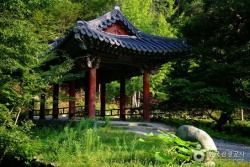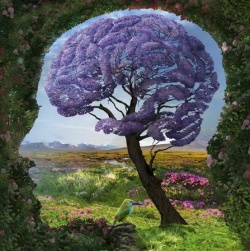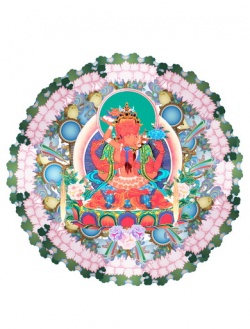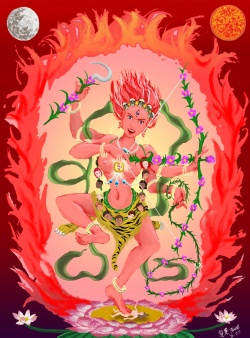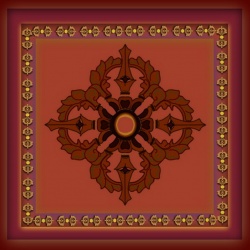Hayagriva
Hayagriva, also spelt Hayagreeva; (Sanskrit: हयग्रीव, IAST: hayagrīva) is a horse-headed avatar of the god Vishnu in Hinduism. In Sanskrit, Hayagrīva means haya = Horse, grīva = Neck.
Hinduism
In Hinduism, Hayagriva is also considered an avatar of Vishnu. He is worshiped as the God of knowledge and wisdom, with a human body and a horse's head, brilliant white in color, with white garments and seated on a white lotus. Symbolically, the story represents the triumph of pure knowledge, guided by the hand of God, over the demonic forces of passion and darkness.
Hayagriva is a very important deity in the Vaishnava tradition. His blessings are sought when beginning study of both sacred and secular subjects. Special worship is conducted on the day of the full moon in August (Śravaṇa-Paurṇamī) (his avatāra-dina) and on Mahanavami, the ninth day of the Navaratri festival. He is also hailed as "Hayasirsa". Hayaśirṣa means haya=Horse, śirṣa=Head.
- In IAST
- jñānānanda mayaṃ devaṃ nirmala sphaṭikākṛtiṃ
- ādhāraṃ sarvavidyānaṃ hayagrīvaṃ upāsmahe
- In Devanāgarī
- ज्ञानानन्द मयं देवं निर्मल स्फटिकाकृतिं
- आधारं सर्वविद्यानं हयग्रीवं उपास्महे
This verse is originally from the Pañcarātra Agamas but is now popularly prefixed to the Hayagriva Stotram of the 13th-century poet-philosopher Vedanta Desika. It is very popular among devotees of Hayagrīva.
Hindu iconography
Vedanta Desika's dhyāna-śloka (meditative verse) on Hayagrīva typifies this deity's depiction in Hindu iconography:
- He has four lotus hands, with one in the mode of bestowing knowledge; another holds books of wisdom, and the other two hold the Conch and Discus. His beauty, like fresh cut crystal, is an auspicious brilliance that never decays. May this Lord of speech who showers such cooling rays of grace on me be forever manifest in my heart!
- In the Mahavairocana-sutra Sūtra of the Great Sun translated and copied in 1796 by I-hsing it says:
- “Beneath the buddhas is Hayagriva. His body is the color of the sun at dawn. He wears flaming effulgence and skulls as a garland. His nails are long and sharp; his face shows a pair of bare tiger’s fangs. His hair is that of a burning lion’s mane. He is awesomely powerful and fierce! This is the fierce Vidyaraja wrathful vehicle of the Lotus section. He is just like a horse-jewel of a Cakravartin that wanders the four continents, nowhere and never does he rest, having all the great and terrible force of all the buddhas’. This is his nature, and therefore he possesses this terrible and all-mighty light. Amidst the greatest obstacles of death and evil he is without the slightest care for his own welfare, his conspicuous and uncommon gallantry, intrepidity, and wrath is legendary among the gods, and therefore he easily and quickly vanquishes all who oppose him! Many others submit to him at first sight! This is because though he is fierce and terrible; his heart is full of compassion (unbiased, dispassionate understanding).”
- -- Hayagrīva Stotram, v.32
Later on Hayagriva is referred to as the “Horse necked one”, Defender of faith”, the “Terrible executioner”, the “Excellent Horse”, and the “Aerial horse”.
This said, the Horse god is seen as pulling the sun up to the heavens every day, bringing light to darkness. Hayagriva’s consort is Marichi (Marishi-Ten/摩利支天) and or Lakshmi (possibly an avatar of Marichi or Kan'non), the goddess of the rising sun, more accurately the sun’s light which is the life force of all things, and which is seen as the female in, yin aspect of Hayagriva. This relationship is the classic nonduality of the Hindu tantra. Marichi represents the essence of the power of creation of the cosmos, and is the in/yin half of Dainichi Nyôrai. Whereas Hayagriva represents the other yang/yô aspect, that of the manifestation of the power of yin/in as action. In other words, Hayagriva represents the manifestation of yin/in as the power and action of the cosmos manifested as action. This is the very definition of tantra, that of action.
In several other sources he is a white horse who pulls the sun into the sky every morning. In others such as the great epic Taraka-battle where the gods are fallen on and attacked by the danava’s [[[Wikipedia:demons|demons]]], Vishnu appears as a great ferocious warrior called Hayagriva when he comes to their aid. It says;
“Hayagriva appears in his chariot, drawn by 1,000 powerful steeds, crushing the enemies of the gods beneath him!”
There are many other references to Hayagriva throughout the Mahabharata. It is said that Vishnu comes from battle as a conqueror in the magnificent mystic form of the great and terrible Hayagriva;
“The great Hayagriva having been praised in this way by the different saints and ascetics, assumes a great white horses head. The verda’s mantras made up his shape, his body built of all the great gods; in the middle of his head was Shiva, in his heart was Brahmā god of heaven; the rays of sun (Marichi) were his mane, the sun and moon his eyes; the Vasus and Sadhyas were his legs, in all his bones were the gods. Agni Ka-ten; god of fire was his tongue, the goddess Satya his speech, while his knees were formed by the Maruts and Varuna. Having assumed this form, a awesome wonder to behold to the gods, he vanquished the asura, and cast them down, with eyes that were red with anger.”
Invariably, Hayagriva is depicted seated, most often with his right hand either blessing the supplicant or in the vyākhyā mudrā pose of teaching. The right hand also usually holds a akṣa-mālā (rosary), indicating his identification with meditative knowledge. His left holds a book, indicating his role as a teacher. His face is always serene and peaceful, if not smiling. Unlike his Buddhist counterpart, there is no hint of a fearsome side in the Hindu description of this deity. Indeed, the two deities seem to be totally unrelated to one another.
Hayagriva is sometimes worshiped in a solitary pose of meditation, as in the Thiruvanthipuram temple. This form is known as Yoga-Hayagriva. However, he is most commonly worshipped along with his consort Lakshmi and is known as Lakshmi-Hayagriva. Hayagriva in this form is the presiding deity of Mysore's Parakala Mutt, a significant Sri Vaishnavism monastic institution.
In Sakta mythology
In the Sakta tradition of Hinduism, Hayagriva occupies a different role. Here, a demon named Hayagriva first appears as son of Kaśyapa Prajāpati. Through great penance the demon managed to obtain a boon from the Goddess Durga that he can only be killed by another "Hayagriva". This instilled a sense of invincibility and he started harassing the Devas. The Devas turned to Vishnu for aid, but despite a long struggle he was also unable to kill Hayagrīva.
Tired and drained after the battle, Vishnu proceeded to Vaikuntha Dharma to rejuvenate and meditate in padamāsana (a yoga posture) with his head supported by the upper end of his taut bow. The Devas once again approached Vishnu for help against Hayagrīva but were unable to rouse him from his meditation. The Devas asked a swarm of termites to assist in waking Vishnu by gnawing away the string of the bow upon which he was resting. However, the snapping of the bow string produced such a resonant sound that the universe trembled, and the broken string lashed out with such force that Vishnu's head was severed from his body.
The Devas were mortified, and prayed to the goddess Durga for guidance. Durga was pleased with their prayers and told the Devas that they need not fear, as no incident in this universe was without some purpose. She then told them of her boon to Hayagriva and asked them to attach the head of a horse to Vishnu so that he in the guise of "Hayagriva" (that is, one with a horse's neck) could kill his foe.
Brahma attached the head of a white horse to Vishnu's body and the revived Vishnu entered into battle with Hayagriva and eventually killed him.
Another legend has it that during the creation, the demons Madhu-Kaitabha stole the Vedas from Brahma, and Vishnu then took the Hayagriva form to recover them. The two bodies of Madhu and Kaitabha disintegrated into twelve pieces (two heads, two torsos, four arms and four legs). These are considered to represent the twelve seismic plates of the Earth. Yet another legend has it that during the creation, Vishnu compiled the Vedas in the Hayagrīva form.
Some consider Hayagriva to be one of the Dashavataras of Maha Vishnu. He along with Śrī Krishna, Shrī Rama and Shri Narasimha is considered to be an important avatar of Maha Vishnu.
Lord Hayagriva's Sannithanam is there in Sri rangam Temple. Hayagreev in Srirangam is very famous for children's education. The Sannithanam is very beautiful and all rituals done according to Vedic principles very strictly.
Hayagrīva Mahatmyam
A great devotee named Śrī Vadirajatirtha of Udupi Śrī Kṛṣṇa Mutt used to offer cooked horse gram (Kollu) to Lord Hayagreeva. He used to recite the Hayagrīva Śloka and keep the offerings on his head. Lord Hayagrīva would come as a beautiful white horse form and would eat the horse gram. As a very staunch devotee, Vadirajatirtha would recite the following sloka -
- Na Hayagrivam Pranipathya Seedhathi!
- There is no auspiciousness greater than Hayagrivan. Nothing is more sacred than Sri Hayagrivan to destroy our accumulated sins. No other God is superior to Hayagrivan. No one grieves after performing Śaraṇagati at the sacred feet of Hayagrivan.
Hayagriva is listed as one of the ten incarnations of Vishnu in Canto 10 (skandh 10), chapter 40 of the Śrīmadbhagavatam, and Akrūra's prayer contains Hayagriva's name when he had a vision while bathing in Yamuna.
There is a story that more than 500 years ago, a devotee from the Daivajña Brahmin community was casting an idol of Lord Gaṇapati, when it shaped itself in the image of Lord Hayagriva. Sarvabhauma Sri Vadiraja Guru Swamiji had a dream about this legend which inspired him to approach that devotee and take the idol from him in reverence. He then installed it in Shri Sode Vadiraja Mutt. Since then it has been worshipped there as the originating god of the Daivajnya Brahmin community.
The members of the community who were originally Smartha Brahmins, were instructed in Dvaita philosophy and received into the fold as Mukhya Śiṣyas by the revered Sri Vadiraja Teertha. To this day, Daivajña Brahmins continue to make offerings to the Mutt and Lord Hayagriva.
Source
Hayagriva (Tibetan: tam drin, English: Horse Neck) from the Eight Sadhana Sections of Mahayoga Tantra.
Very wrathful, red in colour, with three faces, six hands and four legs, the right face is white and the left green. With three large round staring eyes and a cavernous mouth with sharp canine teeth and dark hair flowing upward. On top of the head are three small green horse heads. The right hands hold a vajra, trident and sword, and the left upper hand is outstretched in the mudra (sacred gesture) of bestowing protection, the remaining hands hold a spear and noose. Adorned with a crown of five dry skulls, earrings, gold and jewel ornaments, snakes entwined as jewelry and a tiger skin skirt, he is completely attired in wrathful charnel ground vestments and a set of vajra wings. The consort has one face and two hands, blue-black in colour, holding a skullcup in the left hand, adorned in wrathful attire and a leopard skin skirt. Standing with eight legs, the right bent and left straight, atop two corpses above a sun disc and multi-coloured lotus, Hayagriva dwells surrounded by the flames of pristine awareness.
Source
[[Image:TNHayagriva.jpg|thumb|Hayagriva from the thangka of Tendrel Nyesel)]
Hayagriva (Skt. Hayagrīva; Tib. རྟ་མགྲིན་, Tamdrin; Wyl. rta mgrin) — the wrathful manifestation of Avalokiteshvara who symbolizes enlightened speech, usually depicted as red in colour and with a horse's head protruding from his crown.
Forms
In the Kagyé
Hayagriva is one of the eight principal deities of Kagyé where he is referred to as Lotus-like Speech (Wyl. pad ma gsung). The instructions related to this form of Hayagriva are based on the so-called "three neighs of the horse"[1]
In the Longchen Nyingtik, the Hayagriva practice related to Palchen Düpa is called "The Play of the Three Realms" (rta mgrin khams gsum rol pa).
Footnotes
- ↑ See Kongtrul (2005), p. 322
Further Reading
- Jamgön Kongtrul Lodrö Tayé, The Treasury of Knowledge: Systems of Buddhist Tantra, Ithaca: Snow Lion, 2005
External Links
Source
Hayagriva (Horse Head Vajra Deity): Wrathful manifestation of Avalokiteshvara Bodhisattva having the wings of a garuda and at least one horse head in his hair. One of the “Eight Guardians of the Law” and one of the ten dharma protectors in the Lineage of Dorje Chang Buddha III.
Source
Hayagrīva. (T. Rta mgrin; C. Matou Guanyin; J. Batō Kannon; K. Madu Kwanŭm 馬頭觀音). In Sanskrit, “Horse-Necked One”; an early Buddhist deity who developed from a Yakṣa attendant of Avalokiteśvara into a tantric wrathful deity important in the second diffusion of Buddhism in Tibet. The name “Hayagrīva” belonged to two different Vedic deities, one an enemy of Viṣṇu, another a horse-headed avatāra, or manifestation, of that deity. Eventually the two merged, whence he was absorbed into the Buddhist pantheon. In early Buddhist art, Hayagrīva frequently appears as a smallish yakṣa figure attending Avalokiteśvara, Khasarpaṇa , Amoghapāśa, and Tārā; by the mid-seventh century, however, Hayagrīva had merged with Avalokiteśvara to become a wrathful form of that bodhisattva. He appears in this new form, Hayagrīva–Avalokiteśvara, in the Avalokiteśvara sections of the Dhāraṇīsaṃgraha (where his Dhāraṇīs are said to be effective in destroying mundane obstacles) and later Chinese translations of the Amoghapāśahṛdaya, as well as in the Mahāvairocanasūtra. While he does appear with a horse’s head in Japan (where he is considered a protective deity of horses), Hayagrīva is customarily shown with a horse head emerging from his flaming hair. In the tantric pantheon, Hayagrīva initially occupied outer rings of the Maṇḍala, but eventually came to be considered a Yidam in his own right, a transformation that would grant him the status of a fully enlightened being. In Mongolia he is worshipped as the god of horses. In Tibet he is primarily worshipped as a Lokottara (supramundane) Dharmapāla (dharma protector).
Source
The Princeton Dictionary of Buddhism by Robert E. Buswell Jr. and Donald S. Lopez Jr.
